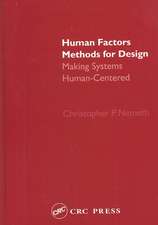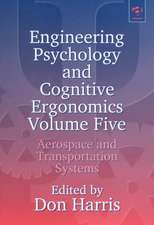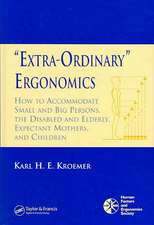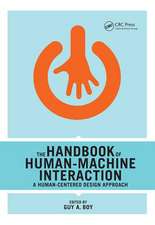Innovation and Consolidation in Aviation: Selected Contributions to the Australian Aviation Psychology Symposium 2000
Autor Peter Pfister Editat de Graham Edkinsen Limba Engleză Hardback – 12 noi 2003
| Toate formatele și edițiile | Preț | Express |
|---|---|---|
| Paperback (1) | 469.34 lei 6-8 săpt. | |
| Taylor & Francis – 28 noi 2016 | 469.34 lei 6-8 săpt. | |
| Hardback (1) | 770.98 lei 6-8 săpt. | |
| Taylor & Francis – 12 noi 2003 | 770.98 lei 6-8 săpt. |
Preț: 770.98 lei
Preț vechi: 1031.40 lei
-25% Nou
Puncte Express: 1156
Preț estimativ în valută:
147.53€ • 157.76$ • 123.01£
147.53€ • 157.76$ • 123.01£
Carte tipărită la comandă
Livrare economică 17 aprilie-01 mai
Preluare comenzi: 021 569.72.76
Specificații
ISBN-13: 9780754619994
ISBN-10: 0754619990
Pagini: 360
Dimensiuni: 156 x 234 x 28 mm
Greutate: 0.83 kg
Ediția:1
Editura: Taylor & Francis
Colecția Routledge
Locul publicării:Oxford, United Kingdom
ISBN-10: 0754619990
Pagini: 360
Dimensiuni: 156 x 234 x 28 mm
Greutate: 0.83 kg
Ediția:1
Editura: Taylor & Francis
Colecția Routledge
Locul publicării:Oxford, United Kingdom
Cuprins
Contents: Foreword, Robert Lee. Part I: System Safety and Accident Prevention: Heroic compensations: the benign face of the human factor, James Reason; Aviation safety and human factors: the years to come, Daniel E. Maurino; Managing threat and error: data from line operations, Robert L. Helmreich, James R. Klinect and John A. Wilhelm; Management influence on safety climate, Rhona Flin; Models of bureaucratic failure, Ron Westrum; Culture, systems and change in aircraft maintenance organization, Nick McDonald; Barrier analysis and accident prevention, Erik Hollnagel; Cognitive work analysis across the system life-cycle: achievements, challenges and prospects in aviation, Penelope M. Sanderson; Human factors reporting and situation awareness, Mike O'Leary. Part II: Contrasting Human Factors Applications in Aviation, Healthcare and Nuclear Power: Threat and error in aviation and medicine: similar and different, Robert L. Helmreich; Managing human factors at Qantas: an investment in the future, Ian Lucas and Graham Edkins; CRM behaviour and team performance under high workload: outline and implications of a simulator study, Barbara Klampfer, Ruth Haeusler and Werner Naef; Stretching the search for the 'Why' of error: the system approach, Marilyn Sue Bogner; Betty and the general, Jan M. Davies; Managing human performance in the modern world: developments in the US nuclear industry, John Wreathall and Ashleigh Merritt. Part III: Training, Licensing and Regulations: Artificial seasoning: enhancing experience-based training for aviation, David O'Hare; Decision skills training for the aviation community, Gary Klein; Ab-initio flight training and airline pilot performance: differences in job requirements, Peter Maschke and Klaus-Martin Goeters; Validating a computer-based training tool for in-flight weather-related decision-making, Mark Wiggins, David O'Hare and Oliver Lods; Learning to land: the role of perceptual feedback and individual differences, Susannah J. Tiller, Peter Pfister, Allen T. G. Lansdowne, Stephen C. Provost and David J. Allerton; A cognitive approach to the development of prescriptions for a new flight crew licence: psychological perspective from a regulator and curriculum designer, Graham J. F. Hunt and Richard Macfarlane; Legislating behaviour: the regulator's dilemma, Mick Toller. Part IV: Automation and Human Computer Interaction: Auditory warnings in the cockpit: an evaluation of potential sound types, Karen L. Stephan, Sean E. Smith, Simon P. A. Parker, Russell L. Martin and Ken I. McAnally; Dealing with conflicting information: will crews rely on automation?, Kathleen L. Mosier, Jeffrey Keys and Robert Bernhard; Development of hazard analysis techniques for human-computer systems, Andrew Neal, Michael Humphreys, David Leadbetter and Peter Lindsay; General aviation pilot attitudes towards GPS use: operational implications, Michael D. Nendick, Ross St. George, Kurt M. Joseph and Kevin Williams. Part V: Human Factors Applications within the ATS Environment: Protecting the ATM system from human error: the JANUS approach, Anne R. Isaac; Prospective memory in air traffic control, Shayne Loft, Michael Humphreys and Andrew Neal; Human factors issues in CPDLC, John Allin Brown. Part VI: Other Human Factors Issues: Alertness and awareness of long haul aircrews: the contribution of a new interface concept as an effective fatigue countermeasure, Jean-Jacques Speyer, Adrian Elsey, Philippe Cabon, Regis Mollard, Samira Bougeois-Bougrinne, Nicolas Parriaux and Marc Perrinet; Inadvertent slide activation, Dieter Reisinger.
Recenzii
'At first this book appears to be an eclectic collection of chapters addressing disparate human factors issues. Don’t be fooled, though. The chapters in this volume represent a comprehensive overview of many of the most pressing human factors problems in the fields of aviation and medicine. The book’s contributors are an outstanding international collection of recognised experts drawn from all facets of industry and academia, who are well placed to recognise these issues. Their chapters address a vast range of issues, from macro-level organisational safety issues to very specific topics, such as inadvertent evacuation slide activation. Anyone with a professional interest in aviation will find something of value within its pages. If you want to know what the human factors research agenda is for the first decade of the 21st Century, this book is an excellent place to start.' Dr Don Harris, Cranfield University, UK
Descriere
Expanding the contribution of aviation psychology and human factors to the aviation industry within the Asia Pacific region, with global expert participation, to optimize the safety, efficiency and viability of the industry.



















